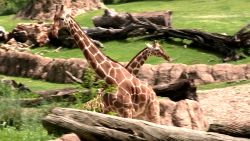Apart from the asteroid that wiped out the dinosaurs 65 million years ago, there aren’t many connections between space and dinosaurs outside of the imagination. But that all changed when NASA research scientist Jessie Christiansen brought the two together in an animation on social media this month.
For the past decade, Christiansen has studied planet occurrence rates, or how often and what kinds of planets occur in the galaxy, while studying data from exoplanet hunters such as NASA’s Kepler, K2 and TESS missions.
During a stargazing party at the California Institute of Technology, Christiansen was explaining how young the stars were that they observed. The skywatchers were looking at the Pleiades, a bright young cluster of stars that are some of the youngest in our sky.
They’re 13 million years old, which sounds ancient. Christiansen wanted to convey that astronomically, that’s still a young age.
She told her fellow stargazers that before they went extinct, dinosaurs wouldn’t have even seen these stars in the sky because they didn’t exist until millions of years after the extinction event. And she told them that when dinosaurs such as stegosaurs roamed the Earth, our entire solar neighborhood was on the opposite of the Milky Way galaxy that it is now.
Christiansen wasn’t sharing new information, she said. But the fact caught everyone’s attention because the movement of our solar system as it orbits the galaxy isn’t something most people think about.
“You don’t think about the sky changing,” Christiansen said. “But the stars come and go, in step with our timescales.”
She had been wanting to create an animation of this intriguing idea for a while and the reaction of the stargazers inspired her one night after her children went to bed. Using the classic Milky Way illustration, as if it were viewed from above, by Caltech senior scientist Robert Hurt, Christiansen built the animation using timed slides in PowerPoint. Then she recorded the screen to create a video she could share on Twitter.
She wanted to share the idea that even though astronomical timescales seem vastly different from our own, they actually match up quite well with archaeological timescales.
The animation shows that it takes anywhere between 200 to 250 million years for the sun to orbit around the center of the galaxy, which is a grand spiral, skirting the dangerous middle that would be inhospitable to life.
Based on our current position in the galaxy and the timescales shared in the animation, we’ve essentially completed an orbit of it.
The last time our solar neighborhood was in this part of the galaxy, relatively speaking, the earliest of the dinosaurs began to appear on Earth during the Triassic period. After that, the Jurassic Period lasted for 55 million years, followed by the Cretaceous Period, which lasted until the dinosaurs went extinct 65 million years ago.
Dinosaurs such as Stegosaurus, Iguanodons and Giganotosaurus lived during the early Cretaceous while Earth was on the other side of the galaxy. The long 79-million-year stretch of the Cretaceous period largely happened there. To put things in perspective, Tyrannosaurus rex existed on Earth when it was in a part of the galaxy that is closer to our current position than many other dinosaurs.
The extinction event 65 million years ago was followed by the rise of mammals and we’re still in that “phase,” so to speak. At the end of the animation, Christiansen proposes an intriguing question: What will be on the planet the next time we complete another orbit?
Christiansen used simplifications for her animation but explained some of the more complex science behind this orbit.
While astronomers are still learning how stars rotate around the center of the galaxy, ultimately everything in our galaxy is spinning around the black hole at its center. The stars closer to the center spin faster, while those in the outer regions spin more slowly. Our solar system is in one of the galaxy’s spiral arms and the whole arm travels together around the galaxy, including the other stars in our “neighborhood,” Christiansen said.
And the Milky Way galaxy itself is moving toward its large neighbor, the Andromeda galaxy. The two are on a collision course and will come together in about 4 billion years. While that sounds violent, galaxies are largely empty space and the stars won’t collide with each other, Christiansen said.
So, relatively speaking, we’re back to where we were between 200 to 250 million years ago. But based on our orbit of the Milky Way, which itself is moving and spiraling, we’ve never really back at the same absolute point in space because it’s not possible.
“The simple idea I was trying to get across is, astronomy has certain timescales, and archaeology has them, and sometimes they match up. Isn’t that cool?”
























